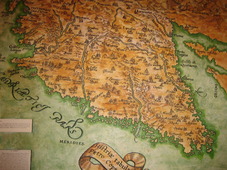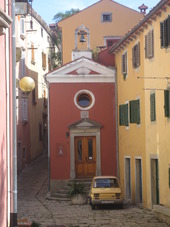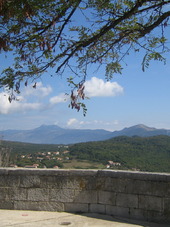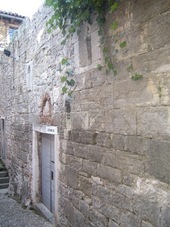to enlarge


or choose the place
from the menu below
 Rome |
 Byzantium |
 Venice |
 Vienna |
 Brioni |
 Smrikve |
 |
 |
 The passage that brings you in the court yard is used today as lapidarium. There are
also two interesting vaults with stone columns. On the right side of the right vault you will find the stairs that will bring
you to the museum of Matthias Flacius Illyricus.
The passage that brings you in the court yard is used today as lapidarium. There are
also two interesting vaults with stone columns. On the right side of the right vault you will find the stairs that will bring
you to the museum of Matthias Flacius Illyricus.
Matthias Flacius Illyricus was a Protestant theologist, philosopher and historian that lived in the 16th century. In the museum will get the feeling of how much Matthias has written in his life. It is really a huge amount of work.
Matthias Flacius was from Fankovic family but was born in Krapan, a small village outside Labin.
From the museum just get back to the street and continue to follow the tour. The first important building is again on your left side and it dates back into the 16th – 17th century. This was the towns hospital.
It is a simple building with a façade that would need restructuring. The building that is attached to the former hospital from the 16th century with a coat of arms and an interesting doorway belonged to the Negri family.
 In this area you will have the feeling to be in a small square with the Church of St.
Mary of Carmel from 1615 that close the north eastern side.
In this area you will have the feeling to be in a small square with the Church of St.
Mary of Carmel from 1615 that close the north eastern side.
Near to the Church of St. Mary of Carmel, on the opposite site of the street, you will note another nice made doorway with a stone made family coat of arms above it.
This building belonged to the family Manzini and dates back into the 17th century. Family Manzini - Depangher restructured the Church of St. Mary of Carmel and its neo classic façade dates back into 1876.
The buildings that you see on your left side were built in the 16th and 17th century and have expanded the town defence walls into that area. Since the town, because of its strategic importance, expanded it was given a new ring of walls which encompassed the slopes of the hill named in Croatian “dolica”.
The oldest town walls made by the Aquileia Patriarchs in the 12th century were limited to a half of the area that we consider today as the Labin old town.
To get an idea you have to imagine the town walls finishing in the area of the palace Lazzarini Battiala. This upper area near the hilltop was named in Croatian “gorica”.
 If you continue the tour from the square where the Church of St. Mary of Carmel is located I would just remind
you that the town walls from the 15th century made by Venetians were ending up where this square and street
is formed. If you continue to walk towards the hilltop on your right side you will note the remains of the Venetian walls
from the 15th century.
If you continue the tour from the square where the Church of St. Mary of Carmel is located I would just remind
you that the town walls from the 15th century made by Venetians were ending up where this square and street
is formed. If you continue to walk towards the hilltop on your right side you will note the remains of the Venetian walls
from the 15th century.
On the top of the hill you will enjoy a beautiful views towards Ucka Mountain located in the north - eastern part of Istria. You will also see the sea and the Cres island in the Quarner Bay. If you take a look towards south you will note the 33 meters high bell tower of the Church of St.Justus from 1623. Today the bell tower is used for the panoramic view.
 If you start to walk towards the bell tower
in a parallel street from where you enjoyed the view towards north eastern part of Istria you will note an interesting façade
with a Renaissance window on the first floor and an interesting stone sculpture on façade.
If you start to walk towards the bell tower
in a parallel street from where you enjoyed the view towards north eastern part of Istria you will note an interesting façade
with a Renaissance window on the first floor and an interesting stone sculpture on façade.
When you arrive near the bell tower of St. Justus you will also note that the wall you have in front of you seems to be a façade of a church. This part is the oldest part of Labin.
In fact the ruins of the Church of St. Justus dates back into the 10th century. It is likely that the primitive church was built already in the 6th century.